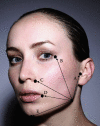Systemic Use of Arnica Montana for the Reduction of Postsurgical Sequels following Extraction of Impacted Mandibular 3rd Molars: A Pilot Study
- PMID: 33381206
- PMCID: PMC7749769
- DOI: 10.1155/2020/6725175
Systemic Use of Arnica Montana for the Reduction of Postsurgical Sequels following Extraction of Impacted Mandibular 3rd Molars: A Pilot Study
Abstract
Background: Postsurgical sequels (PSS) are a group of complications commonly encountered following invasive dental surgical procedures such as bone grafting procedures, external sinus grafting, and 3rd molar extractions. These include pain, intraoral and extraoral bruising, and edema. The aim of this study is to evaluate the clinical efficacy of arnica montana (AM) in the management of PSS following extraction of impacted mandibular 3rd molars. The investigators null hypothesis includes no significant role of AM in reducing PSS following dental extraction.
Materials and methods: The investigators implemented a case-control pilot study enrolling twenty-three patients with impacted mandibular 3rd molars. These patients were allocated to AM or control group. Baseline clinical measurements were collected and included: (1) length of the surgical procedure, (2) pain score, (3) maximum mouth opening, and (4) facial measurements to evaluate edema levels. Subjects in active group received systemic AM tablets following the manufacturer instructions. All study subjects were followed up on Days 2, 4, and 7. Data was analyzed for statistical significance.
Results: A total of 30 impacted mandibular 3rd molars were extracted, in which 22 completed with AM. There were 16 females, and the average age was 26 years. On Day 2, subjects in the AM group reported significantly lower VAS compared to control group (3.09 ± 2.22 versus 4.75 ± 1.28). In addition, bleeding, extraoral bruising, edema, and decrease in maximum mouth opening were significantly less reported in the AM group.
Conclusions: This study describes the potential benefit of AM in reducing PSS following dental extractions.
Copyright © 2020 Hani Mawardi et al.
Conflict of interest statement
The authors declare that there are no conflicts of interest regarding the publication of this article.
Figures




Similar articles
-
The effect of kinesio taping with the web strip technique on pain, edema, and trismus after impacted mandibular third molar surgery.Niger J Clin Pract. 2020 Sep;23(9):1260-1265. doi: 10.4103/njcp.njcp_23_20. Niger J Clin Pract. 2020. PMID: 32913166 Clinical Trial.
-
Autogenous Dentin Grafting of Osseous Defects Distal to Mandibular Second Molars After Extraction of Impacted Third Molars.Compend Contin Educ Dent. 2020 Feb;41(2):76-82; quiz 83. Compend Contin Educ Dent. 2020. PMID: 32017585
-
Piezo-surgery technique and intramuscular dexamethasone injection to reduce postoperative pain after impacted mandibular third molar surgery: a randomized clinical trial.BMC Oral Health. 2021 Aug 11;21(1):393. doi: 10.1186/s12903-021-01759-x. BMC Oral Health. 2021. PMID: 34380473 Free PMC article. Clinical Trial.
-
Impact of Aprotinin - A Proteolytic Enzyme on Postsurgical Symptoms in Patients Undergoing Third Molar Surgeries.J Clin Diagn Res. 2016 Jan;10(1):ZC18-22. doi: 10.7860/JCDR/2016/15491.7056. Epub 2016 Jan 1. J Clin Diagn Res. 2016. PMID: 26894169 Free PMC article.
-
Efficacy of adjuvant laser therapy in reducing postsurgical complications after the removal of impacted mandibular third molars: A systematic review update and meta-analysis.J Am Dent Assoc. 2017 Dec;148(12):887-902.e4. doi: 10.1016/j.adaj.2017.06.043. Epub 2017 Oct 5. J Am Dent Assoc. 2017. PMID: 28987483
Cited by
-
Topical-Ozonized Olive Oil - A Boon for Post-Extraction Cases: A Randomized Controlled Trial.Cureus. 2023 Jan 31;15(1):e34478. doi: 10.7759/cureus.34478. eCollection 2023 Jan. Cureus. 2023. PMID: 36874664 Free PMC article.
-
Effects of Arnica Phytotherapeutic and Homeopathic Formulations on Traumatic Injuries and Inflammatory Conditions: A Systematic Review.Plants (Basel). 2024 Nov 4;13(21):3112. doi: 10.3390/plants13213112. Plants (Basel). 2024. PMID: 39520030 Free PMC article. Review.
-
Clinical Trials, Potential Mechanisms, and Adverse Effects of Arnica as an Adjunct Medication for Pain Management.Medicines (Basel). 2021 Oct 9;8(10):58. doi: 10.3390/medicines8100058. Medicines (Basel). 2021. PMID: 34677487 Free PMC article. Review.
-
Efficacy of submucosal administration of tramadol on acute pain following third molar surgery: a systematic review and meta-analysis.Front Oral Health. 2024 Nov 18;5:1360298. doi: 10.3389/froh.2024.1360298. eCollection 2024. Front Oral Health. 2024. PMID: 39624649 Free PMC article.
References
-
- Glera-Suarez P., Soto-Penaloza D., Penarrocha-Oltra D., Penarrocha-Diago M. Patient morbidity after impacted third molar extraction with different flap designs. A systematic review and meta-analysis. Medicina oral, patología oral y cirugía bucal. 2020;25(2):e233–e239. doi: 10.4317/medoral.23320. - DOI - PMC - PubMed
LinkOut - more resources
Full Text Sources
Medical
Miscellaneous

